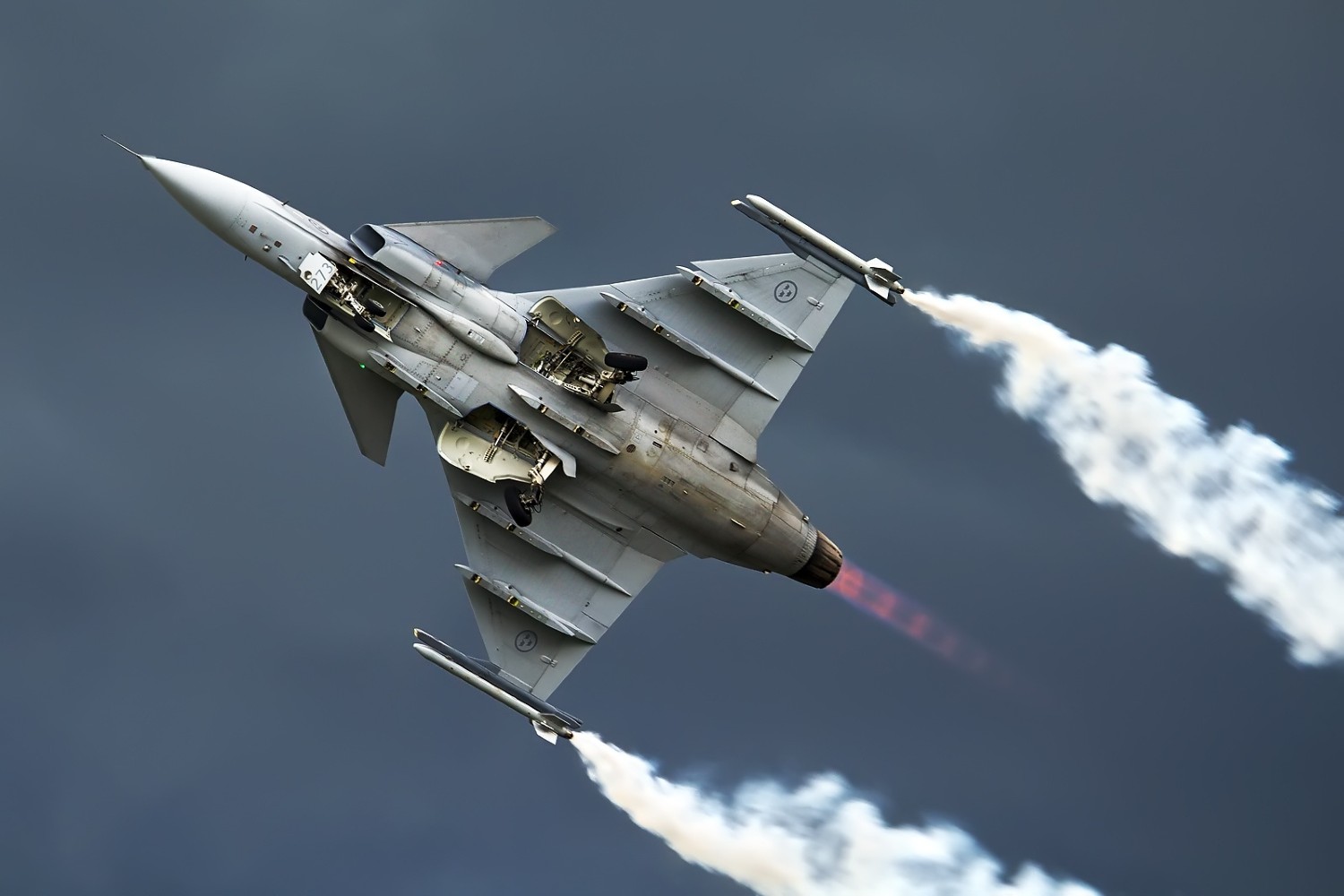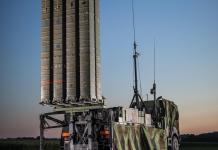As India remains invested in evaluating its choices and working out the details for the MRFA contract for new multi-role fighter jets, Swedish defense manufacturer’s Indian arm ‘SAAB India’ is courting the Indian Air Force (IAF) once again to buy its Gripen-E fighter jets.
SAAB India published a statement on its official account on Platform X (previously Twitter) offering its Gripen-E fighter jet to the IAF again. The development comes when SAAB aggressively pitches the Gripens to countries globally but with little to no success almost anywhere.
A post on August 28 said, “Saab will offer 114 state-of-the-art Gripen E fighters as a part of its response to the upcoming IAF RFP. With Gripen E, India will get next-generation combat air capability and world-class availability – ready to face any threat, anytime, anywhere, from any dispersed location.”
It was in 2018 that India sent Requests for Information (RFIs) for 114 medium multi-role fighter aircraft tenders to prospective participants. This purchase is meant to compensate for the IAF’s continuous depletion of combat-ready squadrons by the steady phase-out of older aircraft in recent years.
Earlier, SAAB India had partnered with India-based Adani group in 2017 to bolster its position in the competition to supply India’s Air Force with brand-new jets. However, on January 19 this year, the company officially announced that the agreement with the Adanis had ended.
Saab has been actively promoting its Gripen fighter aircraft to the Indian Air Force. The Rafale outperformed Gripen in a bid to deliver 126 new warplanes to the Indian Air Force, and New Delhi eventually bought 36 French warplanes.
Despite ending the long-drawn partnership with an Indian company, SAAB has continued to pitch its Gripen-E aircraft to the IAF. In October 2022, Saab made a proposal that would directly appeal to India’s ‘Make in India’ policy, focusing on indigenous production of sophisticated weaponry.
Saab will offer 114 state-of-the-art Gripen E fighters as a part of its response to the upcoming IAF RFP. With Gripen E, India will get next-generation combat air capability and world-class availability – ready to face any threat, any time, anywhere, from any dispersed location. pic.twitter.com/A1WQFSOok2
— Saab India (@SaabIndia) August 28, 2023
The statement issued by the company then read, “In India, Saab is committed to the Make in India vision. This commitment includes innovation, design, development, assembly, support, and maintenance. The plan is to involve hundreds of Tier 1, 2, and 3 partners, vendors, and suppliers to create a range of Indo-Swedish systems that can not only support the Indian Armed Forces but also be exported to other countries.”
In addition to this ambitious pitch, the company said that it intended to develop an independent industrial base that would not only design, develop, and maintain the Gripens but also offer technological support for indigenous fighter programs such as the Light Combat Aircraft (LCA) MK2 and Advanced Medium Combat Aircraft (AMCA).
At the Aero India Show this February, the Swedish aerospace and defense giant Saab displayed its Gripen-E at the exposition and offered its single and two-seater Gripen combat aircraft models to the Indian Air Force. This was probably the first time the manufacturer provided India with the two-seat variant.
The single-seater 4.5-generation aircraft produced by Saab, dubbed the Gripen-E, is a top contender for the IAF’s fighter program alongside Lockheed Martin F-21, Boeing F/A-18, Dassault Aviation Rafale, the Eurofighter Typhoon, and the Russian MiG-35.
However, despite renewed efforts at projecting itself as the most suitable choice for the Indian Air Force and its unique requirements, the Swedish manufacturer is believed to be trailing behind the other contenders. For instance, as soon as the post was published, some netizens appreciated the company’s “resilience” in sarcastic replies.
Does SAAB Stand A Chance?
Saab India CMD Mats Palmberg said The Gripen E is the “world’s most advanced multi-role fighter aircraft.” Palmberg made a compelling argument by pointing out that the Gripen E has operational performance, networked warfare capabilities, increased sensor fusion, unique BVR (beyond visual range) features, and the ability to adapt to new threats a decade ahead of other fighters.
“The good thing is that Gripen has been designed for easy maintenance. Everything from personnel training to sourcing maintenance equipment can be done locally. There won’t be any need to fly the fighters to Sweden for any maintenance or upgrade,” Palmberg says.
Saab highlighted Gripen E’s use of cutting-edge networking technology in its briefing. Saab asserts that its aircraft delivers maximum operating availability with the most minor logistical support thanks to its new, more potent General Electric F-414 engine.

The Gripen is regarded as a powerful aircraft due to its lightweight, low radar signature, and capacity to get past enemy air defenses. The multi-role Swedish military aircraft features a digital fly-by-wire control system and a delta-canard design. Its robust search and tracking radar enables “look-down/shoot-down” capability and a “track-while-scan” feature that the pilot can use to evaluate several targets in real-time.
The company actively pushes and puts forward appealing ideas to win the MMRCA 2.0. Given the challenges the company has faced selling its fighter plane to other countries, this contract is more important for the Swedish company.
Although the Gripen-E fighter is undoubtedly a capable aircraft, it has barely succeeded in the contracts it has participated in, including the ones it lost to American fighters.
The last time the fighter was sold was over eight years ago. The US$5.44 billion agreement to supply 36 Gripen fighters to the Brazilian Air Force, which was finalized in 2014, was the company’s previous export order.
India has yet to put out an RFP officially. However, some experts believe the Swedish fighter could eventually lose to the French Rafale or ‘other powerful contenders from powerful countries.’
Previous SAAB India head Ola Rignell had said, “Gripen has the same weapons package as Rafale, including the Meteor air-to-air missile,” emphasizing that the Gripen carried all the NATO missiles except the French SCALP. However, Rignell even offered to integrate SCALP with Gripen if India desired and still failed to impress the country.
Several experts have noted that the Swedish firm does not have the political clout of the Russians, the French, and, more importantly, the United States. The company had earlier accused the United States of bagging contracts based on its political influence, the benefits of which were being reaped by US-based defense contractors like Lockheed Martin.
One earlier concern was that the Gripen-E was a single-seat fighter jet. However, since the company pitched the double-seat variant to India earlier this year, those concerns have been assuaged to some extent. Doubts, nevertheless, persist about whether the manufacturer could deliver a two-seat variant in time if it bags the contract.
A more significant concern, however, is that the Indian Air Force is now keen on a 5th generation aircraft. Analysts use this argument to assert that if India were to settle for a 4.5th generation fighter jet, it might as well be the twin-engine Rafale it already operates.
"next-generation" compared to what ? Rafale that IAF already operates ?
What could your single engine fighter add to IAF that Rafale EH/DH does not already provide ?— Sébastien Clavier 🇫🇷🇪🇺🇺🇳 (@clavierwrkspace) August 28, 2023
Soon after the corporation reposted its pitch on platform X on August 28, a netizen and supposedly a French engineer mocked the ‘next generation appeal’ by asking, “next-generation” compared to what Rafale that IAF already operates? What could your single-engine fighter add to IAF that Rafale EH/DH does not already provide?”
Another reason why the experts believe that the Gripen is unlikely to be a frontrunner despite the big promises made by SAAB is due to the eerie similarities it has with India’s indigenously developed LCA Tejas, which is supposed to become a potent workhorse of the IAF.
Earlier, writing for EurAsian Times, an Indian Defense and Aerospace analyst explored the similarities and differences between the two fighters in-depth. He noted that whichever aircraft wins the deal will operate in the Indian Air Force alongside LCA Tejas Mark 1 and Mark-1A.
Comparing both aircraft based on their features alone, the analyst said that the Indian aircraft might even outperform the Gripen. “The Indian Air Force (IAF) ordered Tejas fighters last year. The aircraft can now be seen evolving to a more powerful and bigger medium fighter jet, which would stand a clear notch above its adversaries, especially SAAB Gripens,” he noted.
He added later, there is no point buying ‘foreign’ LCA Tejas when you already have one back home.
- Contact the author at sakshi.tiwari9555 (at) gmail.com
- Follow EurAsian Times on Google News




